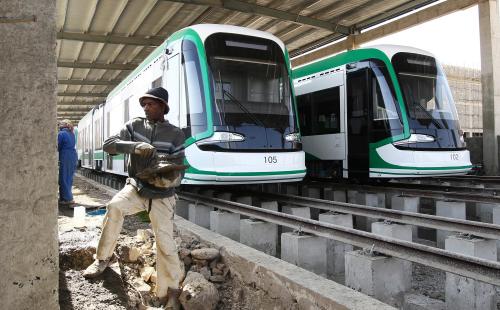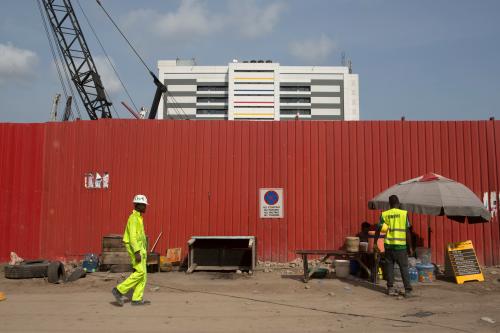Over the past two decades, Ghana’s economy experienced an average annual growth rate of 5.8 percent, and became a low-middle income country in 2007. Though Ghana’s average annual employment growth between 1993 and 2013 has been higher than sub-Saharan Africa’s—3.7 percent versus 3.0 percent—its overall employment growth has not kept up with its economic growth. Notably, Ghana’s impressive economic growth has largely stemmed from crude oil exports, mining, and financial intermediation—all sectors and subsectors in which labor absorption is low. Given these trends, Ghana’s ability to transform its growth gains into better livelihoods for its citizens is being challenged.
In their paper, Understanding Ghana’s growth success story and job creation challenges, Ernest Aryeetey and William Baah-Boateng examine the sustainability of the high growth Ghana has experienced over the last two decades and advise Ghanaian policymakers to rethink their growth strategy.
For a more in-depth look at these and related topics, such as labor productivity, you can read the full paper here.
Ghana’s labor trends
Like in many other sub-Saharan African countries, the agriculture sector is the largest employer in Ghana, though its employment share is decreasing from 61.1 percent in 1984 to 44.7 percent in 2013. In addition, while industry’s employment share has slightly grown from 13.7 percent to 14.6 percent over the same period (and the manufacturing subsector has decreased from 10.9 percent to 9.1 percent), services has grown from 25 percent to 40.9 percent—leading to what the authors refer as a “missing middle.”
As noted above, the authors emphasize that the sectors that have been driving Ghana’s growth are not labor-intensive, namely mining, oil extraction, and finance. While labor has been moving from agriculture to services, the authors note that the trend “may not reflect a structural and productive transformation,” largely because the jobs created in the services sector are mostly informal and have low productivity. Indeed, services sector maintained the lowest annual average growth of labor productivity between 1992 and 2013. As part of these shifts, informal employment—which represented 88 percent of Ghanaian employment in 2013—grew by 3.7 percent on average while formal employment grew by only 2.6 percent during this period.
Unemployment in Ghana remains low, at 5.2 percent, though has experienced significant swings from 2.8 percent in 1984 to 10.4 percent in 2000 to 3.1 percent in 2006. The authors note, though, that these numbers might be deceptive due to the high numbers of informal, vulnerable, and “discouraged workers” (those who are jobless and available for work but fail to make the effort to seek work for various reasons) in Ghana. In fact, they state that, in 2006, after accounting for discouraged workers the unemployment rate more than doubled from 3.1 percent to 6.5 percent.
Vulnerable employment and the working poor
Despite Ghana’s relatively low unemployment rate, many laborers still live in poverty: According to the authors, 22 percent of working people are poor. Many others work in “vulnerable employment”—which the authors define as “a measure of people employed under relatively precarious circumstances indicated by their status in employment. It consists of own account and contributing family work that are less likely to have formal work arrangements, access to benefit or social protection programs, and are more ‘at risk’ to economic cycles (ILO 2009).” This definition is opposed to “productive employment,” or “paid employment and self-employed with employees.” Vulnerable workers are usually found in the informal sector and tend to have lower earnings—a situation exacerbating the ever-widening earnings gap and growing income inequality.
According to the authors, working poverty is closely linked with vulnerable employment, for which seven of 10 jobs in Ghana qualify (Table 1). Some policies, which could combat working poverty, have been somewhat ineffective in reducing poverty: For example, Ghana has been consistent in raising its minimum wage, keeping it largely above the rate of inflation, but this policy tends to only affect those in the formal sector, leaving out workers in the informal sector. This trend has also increased Ghana’s inequality: The Gini coefficient increased from 35.4 percent in 1987/88 to 42.3 percent in 2013.
Table 1: Quantity and quality of employment (percent of employed)
| Economic sector |
1984 | 1992 | 1999 | 2000 | 2006 | 2010 | 2013 |
| Employment-to-population (ratio, SSA) | — | 64.3 | 64.1 | 64.1 | 64.9 | 65.2 | 65.5 |
| Employment-to-population (ratio, Ghana) | 80.2 | 72.9 | 73.9 | 66.9 | 67.7 | 67.4 | 75.4 |
| Economic sector | |||||||
| Agriculture | 61.1 | 62.2 | 55.0 | 53.1 | 54.9 | 41.6 | 44.7 |
| Industry | 13.7 | 10.0 | 14.0 | 15.5 | 14.2 | 15.4 | 14.6 |
| Manufacturing (part of industry) | 10.9 | 8.2 | 11.7 | 10.7 | 11.4 | 10.7 | 9.1 |
| Service | 25.2 | 27.8 | 31.0 | 31.5 | 30.9 | 43.0 | 40.9 |
| Institutional sector | |||||||
| Public | 10.2 | 8.4 | 6.2 | 7.2 | 5.7 | 6.4 | 5.9 |
| Private | 6.0 | 6.1 | 7.5 | 8.9 | 7.0 | 7.4 | 6.1 |
| Informal | 83.8 | 85.5 | 86.1 | 83.9 | 87.3 | 86.2 | 88.0 |
| Type of employment | |||||||
| Paid employees | 16.2 | 16.8 | 13.8 | 16.0 | 17.5 | 18.2 | 22.5 |
| Self-employment | 69.6 | 81.3 | 68.7 | 73.4 | 59.5 | 60.8 | 52.6 |
| Contributing family worker | 12.5 | 1.9 | 17.2 | 6.8 | 20.4 | 11.6 | 22.3 |
| Other | 1.7 | — | 0.3 | 3.8 | 2.6 | 9.4 | 2.6 |
| Quality of employment | |||||||
| Gainful/productive employment* | 20.9 | — | — | 21.2 | 22.0 | 23.1 | 28.7 |
| Vulnerable employment** | 77.4 | 82.5 | 80.8 | 74.9 | 75.4 | 67.5 | 68.7 |
| Working poverty | — | 48.7 | 35.4 | — | 25.6 | — | 22.3 |
Notes: * Gainful/productive employment comprises paid employment and self-employed with employees.
** Vulnerable employment comprises own account and contribution family work.
Source: Computed from Ghana Living Standards Survey (GLSS) 3, 4, 5, and 6; Population Census 1984, 2000, and 2010.
Overall, though, Ghana has made great strides. Vulnerable employment has been declining, and productive employment has risen, gains the author attributes to the drop in working poverty—down from 48.7 percent in 1992 to 22.3 percent two decades later (Table 1). However, they also hint that these improvements could have been even larger had job growth been concentrated in paid employment and self-employed with employees.
The skills gap
In their paper, the authors posit that job creation has occurred in less productive sectors due to a lack of skills and education in the workforce—and skill-intensive jobs/vacancies are instead getting filled by foreign laborers. While the proportion of the labor force with no formal education has significantly fallen from 44.1 percent in 1992 to 25.6 percent in 2013, post-primary education rates have barely risen—from 5.7 percent to 12.1 percent during that same period for secondary, vocational, and technical education. Tertiary is even less—from 2 percent to 5.4 percent. Ghanaian universities have not been training engineers, scientists, and technical workers that could increase the productivity and grow the industrial sector. A shortage of technical and vocational skills also limits this sector. Thus, the authors note, employers are forced to look outside of the country to find the workers with the skills required to do the job. The authors emphasize:
[P]roductive structural economic transformation hinges on the level and quality of education and labour skills. A highly skilled, innovative, and knowledgeable workforce constitutes a key ingredient in the process of structural economic transformation, and as productive sectors apply more complex production technologies and research and development activities increase the demand for education and skills. However, the observed weak human capital base does not provide a strong foundation for structural economic transformation of Ghana.
At the same time, the more educated in Ghana also tend to be more likely to be unemployed due to limited job creation for them in the formal sector. In 2013, the unemployment rates for those with secondary education and above (including tertiary) was over 6 percent. The unemployment rate for those with basic education or less was under 3.3 percent. The authors suggest that this trend is due to the fact that those with less education are more likely to take an informal job, while more educated laborers struggle to find jobs in the small formal sector.
Recommendations
Though Ghana has outperformed many of its sub-Saharan neighbors in terms of job creation and growth, its challenges with declining manufacturing, high informal employment, and low education attainment endanger its momentum. To tackle these obstacles, the authors recommend:
- Adjust the priorities of the growth strategy to promote manufacturing, and reconsider the goal of economic growth for growth’s sake by acknowledging that sustainable growth must be coupled with generation of productive and high-earning jobs for all.
- Create a manufacturing and business-friendly environment by addressing the country’s high interest rates, high taxes, and chronic energy problems, among others.
- Enact policies to enhance the high-productivity, high-labor-absorbing agricultural sector, such as improving agricultural extension, develop irrigation plans, among others.
- Develop policies to increase the number of secondary school graduates as well as students studying science, technology, engineering, and math.
For further discussion and recommendations, read the full paper here.
Note: The African Lions project is a collaboration among United Nations University-World Institute for Development Economics Research (UNU-WIDER), the University of Cape Town’s Development Policy Research Unit (DPRU), and the Brookings Africa Growth Initiative, that provides an analytical basis for policy recommendations and value-added guidance to domestic policymakers in the fast-growing economies of Africa, as well as for the broader global community interested in the development of the region. The six papers, covering Mozambique, Kenya, Ghana, South Africa, Ethiopia, and Nigeria, explore the key constraints facing African economies as they attempt to maintain a long-run economic growth and development trajectory.










Commentary
African Lions: Ghana’s job creation successes and obstacles
June 7, 2016